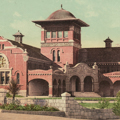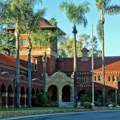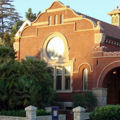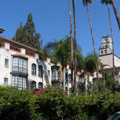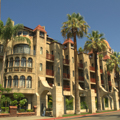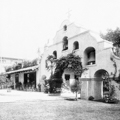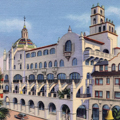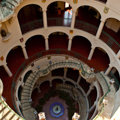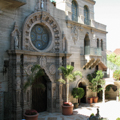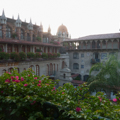The Spanish colonial missions in the American Southwest, built in the seventeenth through nineteenth centuries, have left a lasting impression on the American cultural landscape and psyche. As a colonial project, they subjugated Indigenous populations and coalesced Spain’s control over vast territory. As conurbations, they now form the nucleus of many modern cities. In terms of their built forms, they were notably the inspiration for the Mission Revival style, an architectural and decorative arts idiom that emerged in the late nineteenth century. To understand the genesis of this historicist style, however, one must look at the twenty-one California missions erected between 1769 and 1823 that spanned the coast from modern-day San Diego to San Francisco.
THE SPANISH COLONIAL MISSION SYSTEM AND THE ESTABLISHMENT OF THE CALIFORNIA MISSIONS
In 1524, the Spanish Crown created the Council of the Indies to administer affairs in its newly established colonies. The Council, in turn, established a hierarchy of authority, laws and protocols, and tactics for colonization. From the sixteenth century, Spain’s colonizing efforts in the New World were predicated upon building towns (pueblos), garrisoned forts (presidios), and missions. Of the triumvirate, the missions played a key role whose aim was to convert Indigenous populations to Christianity and assimilate them to Spanish cultural mores through spiritual education as well as the forced adoption of prescribed behaviors, European dress, and the Spanish language. Furthermore, the missions would exploit neophytes (Natives who converted to Christianity) for manual labor, thereby creating an economic engine to ensure the missions’ sustainability and propagation.
California’s missions were the last built in Nueva España. They post-date by at least half a century those built in Arizona, New Mexico, Texas, and Mexico. Even the earliest California mission is a century and a half younger than the oldest in New Mexico, including the Pueblo Mission Church San Felipe, founded 1605, and Nuestra Senora de Guadalupe Mission, founded 1629. That is because as late as the mid-eighteenth century Alta California was a frontier to Spanish colonizers. The sole impetus for establishing missions on the edge of Spain’s influence was geopolitical. With France’s defeat by the British in northeastern North America in 1763, and with Russian expeditions along the Pacific Northwest, Spain feared that its territories in North America—which spread from present-day Louisiana to Baja California—were threatened by expansionism. King Charles III also feared the power the Jesuit order was amassing in their isolated colonial missions; he expelled them from the continent in 1767. He then directed the Franciscans, a religious order founded by St. Francis of Assisi in 1209, to renew colonizing efforts in Alta California. In 1769, Friar Junípero Serra y Ferrer (1713–1784) led the missionizing efforts with expedition-leader Gaspar de Portola and a regiment of soldiers. On July 16, 1769, the first mission—Mission San Diego de Alcalá—was established in what is now the city of San Diego; it is considered the first permanent European settlement in California.
Thenceforth, the founding of missions followed a pattern that embodied ecclesiastical, agricultural, and military programs. They were strung south to north along the rudimentary road El Camino Real, within a day’s horseback ride (approximately 30 miles) from one another. Potential building sites were chosen according to three criteria: arable soil for agriculture, ample water supply, and proximity to a substantial local Native population who would become converts and provide labor. Indigenous laborers cleared land and built roads and structures, the latter including barracks, storehouses, corrals, and a chapel. The first buildings were constructed of thatch and sticks plastered in mud or clay; more permanent edifices in adobe bricks or stone came later, under the aegis of Friar Fermín de Francisco de Lasuén de Arasqueta, who succeeded Serra as the director of the California mission system upon the latter’s death in 1784.
Typically, the missions’ layouts followed a formula established by the Laws of the Indies, which governed town planning in all Spanish colonies. At first the California missions, beginning with Mission San Diego de Alcalá, were an element within the presidios. Perimeter structures (such as barracks, workshops, storehouses, and stables) created a fortified quadrangle, of which the chapel occupied a modest portion to the side. The San Diego presidio site, however, was poorly chosen, and flooding destroyed the mission’s crops and damaged the buildings. As a result, Serra relocated the mission six miles upstream in 1774. Similarly, Mission San Carlos Borroméo de Carmelo, the second mission founded in Monterey in 1770, was moved out of the presidio to a location closer to the Carmel River within a year of its establishment. These experiences, coupled with other factors, prompted Serra to establish a new pattern of settlement moving forward, wherein the mission became a separate entity from the fort. This not only distanced the neophytes from the soldiers, whom Serra viewed as bad moral influences, but it also asserted autonomy on par with the presidio.
Although the religious function was separated from the military program, the mission building formula replicated the presidio’s fortified quadrangle in which perimeter buildings (such as the cloister dormitories, refectory, workshops, and pantries) formed formidable exterior walls. The church, however, was a key element typically located in the corner, its bell tower rising above the low-slung, horizontal massing of the single-story ancillary structures. An open court, or atrio, in front of the church contained a fountain or lavendaría for communal washing. The porteria or vestibule porch that fronts the wall abutting the church formed the rear wall of the convento, a series of cells facing an inner courtyard. The friars who oversaw the building campaigns replicated but adapted the architecture from their home regions in Spain, with Moorish and Roman elements such as open courts, long colonnades, and arches being typical design tropes.
Despite these consistencies, the missions in Alta California differed from their antecedents as well as from one another in several ways. Unlike the mission churches in Mexico and Texas, which were often vaulted and domed stone edifices [such as San Francisco de la Espada (c. 1731–1745) or the Alamo (c. 1756), both in San Antonio], those in California were frequently erected by unskilled laborers using local materials. Generally, the early California missions were smaller, technologically simpler, and did not express the ornate Baroque forms found in Spanish colonial architecture elsewhere, as seen in the Mission San Xavier del Bac (1783–1797) south of Tucson, Arizona. Contemporary with many of the early California missions, Mission San Xavier del Bac is exceptional in its Byzantine-style domed roofing system. Its elaborate yet naïve painting scheme in the sanctuary, undertaken by neophytes, emulates late Renaissance churches in Mexico. While later churches in California, such as the rebuilt mission churches at Carmel (1793–1797) and Santa Barbara (1815–1820), are more architecturally complex and rendered in higher-quality building materials, none exhibit the level of detail found in San Xavier del Bac.
In plan, the churches could also differ from one another and from their antecedents. Typically, the apse was positioned to the west or north to maximize daylight, not oriented towards the east as in European tradition. The most common forms were narrow rectangles, although San Luis de Obispo has an L-shaped floorplan and three of the missions have cross-transept plans. The quintessential California mission churches’ naves without side aisles have more commonality with New Mexican colonial churches, such as the Pueblo Mission Church of San Agustín (1612–1629), although New Mexican church transept plans could vary as well, such as at San José de Gracia de Las Trampas (1760–1776). Common interior elements are a baptismal font near the entrance, a choir loft over the entry, a pulpit in the nave, and an altar. A church’s interior decor, usually undertaken by the Native neophytes under the supervision of the friars, include shaped stone and timbers used for capitals, corbels, doors, and cabinetry, as well as wall paintings that were architectural, vegetal, or geometric in design and which involved faux marbleizing or mimicked ashlar stonework.
None of the early California missions, such as those built in the time of Serra (1769–1784), were designed by trained craftsman. During the tenure of Lasuén (1784–1803), however, itinerant tradesmen such as carpenters, painters, and muralists from Spain via Mexico began to arrive in Alta California. No records exist that suggest educated architects came to Alta California in this period. The Serra-era missions were designed by the friars sent to these outposts, who brought with them the regional vernacular building traditions of Spain and Mexico. While the construction period of the California missions coincided with the Baroque style in Mexico and the emergence of the Neoclassical style in Madrid (as promoted by the Real Academia de Bellas Artes de San Fernando), the Franciscan friars typically eschewed high styles as too ornate. Yet architectural forms and elements characteristic of several styles can be found in California mission architecture, including Spanish Gothic, Moorish Gothic (Mudéjar), Renaissance, Plateresque or Churrigueresque (Baroque), Rococo, and Neoclassical. In contrast, California mission churches built in the nineteenth century openly embrace high-style architectural design, albeit executed naively due to the level of education and skill of the tradesmen and laborers available. Although the perception of California missions is that they exhibit a vernacular aesthetic that has been dubbed primitive, the Mission San Diego de Alcalá church is identifiably Baroque, the Carmel Mission church is considered a Baroque transitional, and the Mission de Santa Barbara’s church is solidly Neoclassical.
Built and rebuilt over a fifty-year span, the California mission churches lack uniformity in style although their ancillary parts—or the compound considered as a whole—do have several stylistic features in common: flat or low-pitched roofs with deep eaves; arcaded corridors (portales); stepped belfries or campanarios; elaborate bell gables (espadañas); and scalloped parapets or curved pediment gables. The walls were composed of form-molded adobe bricks, made with a crushed-rock or straw aggregate, laid with mud mortars, and applied with stucco. Ceilings were formed of materials gathered from the surrounding environment: redwood timbers formed beams (vigas), between which stripped branches (latillas) were laid (sometimes in a herringbone pattern) and sealed in mud. Floors were either dirt, adobe brick, wood, flagstone, or tile (ladrillo). At first, the missions featured thatched roofs, but later employed fired, square red tiles (teja), first used at Mission San Luis Obispo circa 1780, to mitigate the spread of fire. Stone and wood were used sparingly where they were in short supply. Similarly, the California climate predicated forms and the adaptation of buildings. The thick adobe walls, while structural, insulated the buildings and kept them cool. Deep eaves provided shade, as did ramadas, which have Native origins and were adopted by the friars because of their suitability to the California climate.
Fundamentally, the forms and appearance the missions took relied on four qualities: the friars’ knowledge of architectural precedents; the access (or lack thereof) to skilled tradesmen; adaptation of forms to the climate and environment; and availability of building materials. This historic and geographic context led turn-of-the-century designers to rediscover the missions, preserve them, and reappropriate them to create a Californian architecture inextricably linked to the region’s identity.
NOSTALGIA AND PRESERVATION
Alta California became a province of Mexico when the latter gained its independence from Spain in 1821. This marked the end of the mission system as a colonization tool, although the established missions continued to operate for a time. Beginning in 1834, however, the Mexican government secularized the missions and sold their extensive land holdings to private farmers; suddenly, an elite class of rancheros established an emergent ranching economy. California declared its independence from Mexico in 1836 but did not achieve full sovereignty until a decade later. The Bear Flag Republic lasted four years, until California joined the United States in 1850.
During this period, the missions were largely abandoned or forcibly taken from the Franciscan order, and the structures languished. Many were remade in the Victorian style to reflect the tastes of the East Coast and Midwestern Anglo-Europeans who settled California in the second half of the nineteenth century. Eradication of the Spanish colonial legacy from the built landscape was either intentional or de facto through deferred maintenance and ruination. The newcomers did not believe that the missions, ranchos, and other manifestations of Spanish heritage had any particular architectural or historical significance worth saving.
In the 1880s, however, as interest in Victorian eclecticism began to wane and was supplanted by the architectural ideals of the Arts and Crafts Movement—which valued nature, simple forms, and craftsmanship—the vernacular architecture of the Spanish colonial period was rediscovered. In 1883, the State of Texas purchased the Alamo and opened it as a historic site and tourist attraction. In 1884, Father Angelo Casanova rebuilt the roof of the Carmel Mission, the first act of preservation that would generate an enthusiastic movement to restore the remaining California missions—a movement driven by romanticism, exoticism, and a nostalgia for an antiquated past. This romanticizing of the Spanish colonial past did not consider the labor exploitation and mass conversions of California’s Indigenous populations; instead, it painted the colonial era as an arcadia.
The quintessential expression of this romanticizing is Helen Hunt Jackson’s novel, Ramona (1884), a tragic story of a Scottish-Native American orphan girl living in colonial California. Inspired by Harriet Beecher Stowe’s Uncle Tom’s Cabin, the author intended the fictional story to arouse public concern for the treatment of Native Americans. Instead, readers fixated on the romantic vision of the mission landscape. Indeed, Jackson herself had become enamored of Spanish mission architecture during her California travels, particularly her work as part of an 1882 federal commission to investigate mistreatment of the Native populations by government agents. Jackson’s papers, originally published in 1883, were reprinted in 1886 alongside illustrations by Henry Sandham, which depicted the missions in their ruined states. While Ramona captured the reading public’s imagination, Jackson’s Glimpses of California and the Missions did the most to imprint the building typology’s imagery on the nation’s collective conscious as built representations of a Californian identity. These literary works enticed East Coast readers to believe that California was Eden rediscovered.
Equally for some, the interest in the Spanish colonial era was born from an interest in archaeology and historic preservation. For a brief time starting in 1890, a San Francisco architect named Willis Polk published Architecture News magazine, which featured imagery and stories of the California missions. Tessa Kelso, the head of the Los Angeles Public Library, founded the Association for the Preservation of the Missions in 1892, an organization that was remade into the Landmarks Club in 1895 by Charles Fletcher Lummis, a contributor to the Los Angeles Times and editor of an illustrated monthly entitled Land of Sunshine (Out West after 1912). Lummis spearheaded the restoration of the San Gabriel and San Juan Capistrano missions (the latter undertaken by architect Arthur B. Benton in 1894). By 1910, all the missions were preserved, restored, or entirely rebuilt. Lummis also used his magazine as a platform to promote a new style of architecture that was based on Spanish colonial precedents—one that embraced the cultural and historical symbolism of the missions while imbuing a modern architectural form with a distinct regional identity. This native Californian architecture became known as the Mission Revival.
THE MISSION REVIVAL STYLE
Mission Revival is either considered a sub-category of a larger stylistic umbrella, the Spanish Colonial Revival, or is associated with the Arts and Crafts Movement for its adherence to simple forms. It was a product of the Victorian penchant for exoticism and eclecticism, and can be subdivided into two stages: the Spanish Colonial period (roughly 1885–1905) and the Arts and Crafts period (1905–1915).
The early practitioners of this derivative style did not attempt to replicate eighteenth-century missions with academic exactitude. Instead, the intent was to capture the missions’ general character and romantic atmosphere, the latter of which was well suited to the real-estate and tourist booms that California experienced in the late nineteenth and early twentieth centuries. The style was harnessed by the railroads as early as 1887, when companies designed Mission Revival depots, such as the Atcheson, Topeka & Santa Fe Railway Depot (1898–1902) in Las Vegas, New Mexico, and the Union Pacific Railroad’s Caliente Depot (1922–1923) in Nevada, in order to promote tourism to the American Southwest and Pacific Coast. The style became synonymous with train travel, and even found expression in the East Coast, as evidenced in its use at the Westerly Railroad Station (1912) in Rhode Island. Civic leaders in Southern California towns erected public buildings in the Mission Revival style, while the Boston-based architecture firm of Shepley, Rutan and Coolidge employed it for the buildings on the main campus quadrangle at Stanford University (1886–1906) in northern California. The Mission Revival was also used for new typologies arising in this era, such as motels and motion picture studios.
Alternatively, the efforts to preserve and restore the missions resulted in the Mission Revival style taking another trajectory, one in which a semblance of academic exactitude and faithful replication was desired. Architects like Arthur Benton were interested in the simplicity of form expressed in mission architecture as an alternative to the exuberance of other Victorian styles, such as the Spanish Colonial Revival. Thus, the Mission Revival style became aligned, by some architects and designers, with the Arts and Crafts Movement for its “rudimentary” forms. This is most evident in Gustav Stickley’s line of Mission Style furniture produced in the first decades of the twentieth century. In architecture, Arts and Crafts practitioners adopted a design template for the Mission Revival that began with stuccoed and whitewashed thick planar walls, and featured red terra-cotta roofing tiles as well as what has been called the “Mission Order gable”: a curvilinear gable or pediment like that seen at Mission San Diego de Alcalá. Other oft-used architectural elements include quatrefoil windows, niches, decorative stonework, bell towers, and arcades. Southern California architect Irving Gill experimented with new building materials, especially concrete, in his Mission Revival architecture. Gill’s simplified forms abstracted the Mission Revival to a prototype that is more akin to International Style modernism than to the revivalist styles of the Victorian era.
Like the California missions themselves, the Mission Revival style is varied and nebulous, although it repeats tropes and forms. It can be indiscernible from its close cousins, the Spanish Colonial Revival or Moorish Revival styles, or it can be as minimalist as early Modernist masterpieces. Real-estate, transportation, and leisure industries in the American Southwest and California used the Mission Revival style as a marketing tool to entice travelers, and the style can be seen in almost every typology imaginable, from residences to gas stations. Extremely popular from the 1880s through the 1920s, the Mission Revival is an American design idiom that spread across the nation, although it is intricately linked and based upon a Californian regional identity.
References
Armstrong, Kimberly E. “A Failed Uncle Tom's Cabin for the Indian: Helen Hunt Jackson’s Ramona and the Power of Paratext.” Western American Literature 52, no. 2 (2017): 129-156.
Baer, Kurt. Architecture of the California Missions. Berkeley: University of California Press, 1958.
Bolton, Herbert E. “The Mission as a Frontier Institution in the Spanish Colonies.” American Historical Review 23 (October 1917): 42-61.
Crosby, Harry. Antigua California: Mission and Colony on the Peninsular Frontier, 1697-1768. Albuquerque: University of New Mexico Press, 1994.
Gebhard, David. “The Spanish Colonial Revival in Southern California (1895-1930).” Journal of the Society of Architectural Historians 26, no. 2 (May 1967): 131-147.
Gellner, Arrol. Red Tile Style: America's Spanish Revival Architecture. New York: Viking Studio, 2002.
Hackel, Steven W., ed. The Worlds of Junipero Serra: Historical Contexts and Cultural Representations. Oakland: University of California Press, 2018.
Jackson, Helen Hunt, with illustrations by Henry Sandham. Glimpses of California and the Missions. 1886. Reprint, Boston: Little, Brown, and Company, 1914.
Jackson, Helen Hunt. Ramona. Boston: Little, Brown, 1884.
Kimbro, Edna E., Julia G. Costello, and Tewy Ball. The California Missions: History, Art, and Preservation. Los Angeles: Getty Publications, 2009.
Lake, Alison. Colonial Rosary: The Spanish and Indian Missions of California. Athens: Ohio University Press, 2014.
Lowman, Robert P. The Spanish Missions of California. Arroyo Grande, CA: Lowman Publishing Company, 2011.
Maynard, Theodore. The Long Road of Father Serra. New York: Appleton-Century-Crofts, 1954.
McMillian, Elizabeth. California Colonial: The Spanish and Rancho Revival Styles. Atglen, PA: Schiffer Publishing Ltd., 2002.
Mendoza, Ruben G., and Jennifer Lucido. “Of Earth, Fire, and Faith: Architectural Practice in the Fernandino Missions of Alta California, 1769-1821.” Colonial Latin American Historical Review 2, no. 2 (Spring 2014): 191-237.
Neuerburg, Norman. The Decoration of the California Missions. Santa Barbara, CA: Bellerophon Books, 1987.
Rolle, Andrew and Arthur C. Verge. California: A History. Hoboken, NJ: Wiley, 2014.
Sagarena, Roberto Lint. “Building California’s Past: Mission Revival Architecture and Regional Identity.” Journal of Urban History 28, no. 4 (May 2002): 429-444.
Weitze, Karen. California’s Mission Revival. Los Angeles, CA: Hennessey & Ingalls, 1984.
Winter, Robert, ed. Toward a Simpler Way of Life: The Arts and Crafts Architects of California. Berkeley: University of California Press, 1997.
Writing Credits
If SAH Archipedia has been useful to you, please consider supporting it.
SAH Archipedia tells the story of the United States through its buildings, landscapes, and cities. This freely available resource empowers the public with authoritative knowledge that deepens their understanding and appreciation of the built environment. But the Society of Architectural Historians, which created SAH Archipedia with University of Virginia Press, needs your support to maintain the high-caliber research, writing, photography, cartography, editing, design, and programming that make SAH Archipedia a trusted online resource available to all who value the history of place, heritage tourism, and learning.

